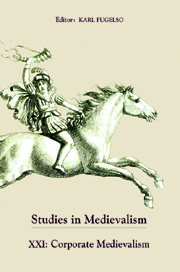Book contents
- Frontmatter
- Acknowledgments
- Contents
- Title in the Series
- Editorial Note
- I Corporate Medievalism: Some Perspective(s)
- II Interpretations
- Historicizing Neumatic Notation: Medieval Neumes as Cultural Artifacts of Early Modern Times
- Hereward the Dane and the English, But Not the Saxon: Kingsley's Racial Anglo-Saxonism
- From Romance to Ritual: Jessie L. Weston's Gawain
- The Cinematic Sign of the Grail
- Destructive Dominae: Women and Vengeance in Medievalist Films
- III Response
- Notes on Contributors
- Title in the Series
Destructive Dominae: Women and Vengeance in Medievalist Films
from II - Interpretations
Published online by Cambridge University Press: 05 February 2013
- Frontmatter
- Acknowledgments
- Contents
- Title in the Series
- Editorial Note
- I Corporate Medievalism: Some Perspective(s)
- II Interpretations
- Historicizing Neumatic Notation: Medieval Neumes as Cultural Artifacts of Early Modern Times
- Hereward the Dane and the English, But Not the Saxon: Kingsley's Racial Anglo-Saxonism
- From Romance to Ritual: Jessie L. Weston's Gawain
- The Cinematic Sign of the Grail
- Destructive Dominae: Women and Vengeance in Medievalist Films
- III Response
- Notes on Contributors
- Title in the Series
Summary
Introduction: The Vengeful Dominae of Die Nibelungen (1924) and Excalibur (1981)
The representation of women in twentieth-century medievalist films has largely been ignored in previous scholarship, which has tended “to privilege the masculine experience.” I propose here that, in the overall trajectory of medievalist film heroines over the course of the century, the dangerous (even bloodthirsty) femme fatale has been a key – albeit rare – character in the cinematic repertoire. She is far less common than various alternative, positively coded, types such as the eager helpmeets and passive beauty queens who assist and inspire heroes such as Robin Hood and El Cid. Nevertheless, violently destructive, vengeful dominae (ruling women, or female lords/domini) are at the narrative heart of two important medievalist films: Die Nibelungen (dir. Fritz Lang, Germany, 1924) and Excalibur (dir. John Boorman, UK, 1981). The two films were made many decades apart, in radically different contexts. The appearance of the figure of the destructive domina in two such superficially different films indicates that she represents one of the fundamental female types of twentieth-century cinematic medievalism.
The dominae of Die Nibelungen and Excalibur are based on characters in the medieval texts that inspired the films, namely the anonymous Middle High German Nibelungenlied (c. 1200), witnessed by a number of thirteenthcentury manuscripts, each of which contains a slightly different version of the text, and Thomas Malory's Middle English Morte D'Arthur (c. 1470), one of the first texts ever printed – and consequently, stabilized – in England (by Caxton, in 1485).
- Type
- Chapter
- Information
- Studies in Medievalism XXICorporate Medievalism, pp. 161 - 190Publisher: Boydell & BrewerPrint publication year: 2012



